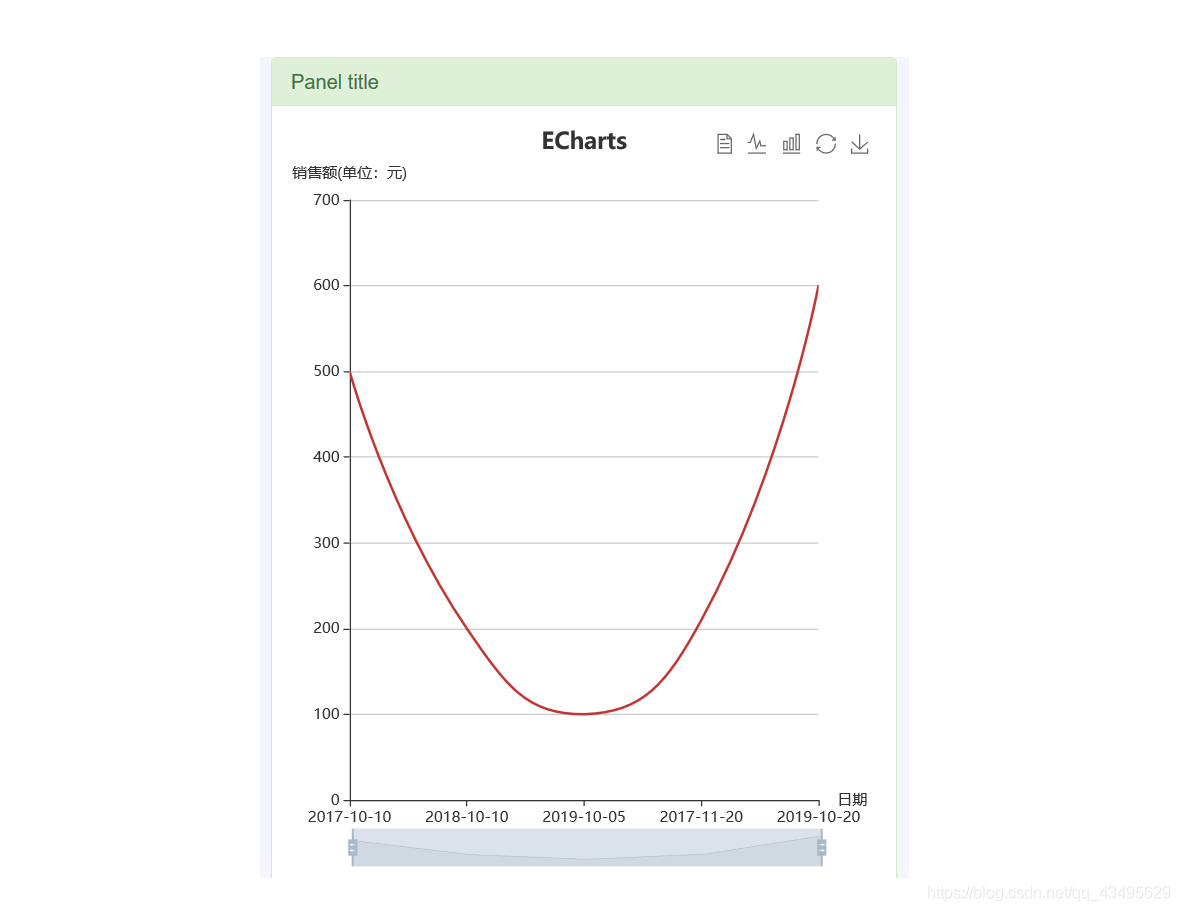php + ajax + mysql + echarts实现动态图表绘制
1.实现步骤:
- 用 php 从数据库里读取数据( PDO )
- 利用 ajax 请求 php 所得到的数据
- 把 ajax 请求到的数据传给 echarts
2.项目结构图:

3.html代码:
- dataIndex.html
<!doctype html> <html lang="en"> <head> <meta charset="UTF-8"> <meta name="Generator" content="EditPlus®"> <meta name="Author" content=""> <meta name="Keywords" content=""> <meta name="Description" content=""> <title>Document</title> <style type="text/css"> .dataSheet4{ width:400px; height:600px; } </style> </head> <body> <div class="dataSheet4" id="data"></div> <!--引入echarts图表框架--> <script src="incubator-echarts-4.2.1/dist/echarts.js"></script> <!--应用ajax所需要的jquery框架--> <script src="https://code.jquery.com/jquery-3.1.1.min.js"></script> <script src="js/dataSheet5.js"></script> </body> </html>
4.js (含 ajax ) 代码:
- dataSheet5.js
// 初始化两个数组,盛装从数据库中获取到的数据 var dates = new Array(), moneys = new Array(); //调用ajax来实现异步的加载数据 function getusers() { $.ajax({ type: "post", async: false, url: "dataIndex.php", data: {}, dataType: "json", success: function(result){ if(result){ for(var i = 0; i < result.length; i++){ dates.push(result[i].times); moneys.push(result[i].money); } } }, error: function(errmsg) { alert("Ajax获取服务器数据出错了!"+ errmsg); } }); return dates, moneys; } //执行异步请求 getusers(); // 基于准备好的dom,初始化echarts实例 var myChart2 = echarts.init(document.getElementById('data')); // 指定图表的配置项和数据 var option = { title: { left: 'center', text: "ECharts" }, tooltip: { trigger: 'axis', backgroundColor:'green' }, toolbox: { show : true, feature : { dataView : {show: true, readOnly: false}, magicType : {show: true, type: ['line', 'bar']}, restore : {show: true}, saveAsImage : {show: true} } }, xAxis: { type: 'category', name:'日期', boundaryGap: false, axisTick: { alignWithLabel: true }, data:dates }, yAxis: { type:"value", name:'销售额(单位:元)', boundaryGap: false, splitLine: { show: true } }, dataZoom: [ { type: 'inside', xAxisIndex: [0], start: 32, end: 56 }, { type: 'slider', xAxisIndex: [0], start: 32, end: 56 } ], series: [ { name:'销售额', type:'line', smooth:true, symbol: 'none', sampling: 'average', data:moneys }] }; // 使用刚指定的配置项和数据显示图表。 myChart2.showLoading( {"text":"正在加载数据"} ); myChart2.hideLoading(); myChart2.setOption(option);
5.php代码:
-
public_function.php
<?php function dbInit(){ global $con; $dsn = "mysql:dbname=info;localhost=127.0.0.1"; $user = "root"; $password = "644066YanMin&&!+"; try{ $con = new PDO($dsn,$user,$password); }catch(PDOExcepetion $e){ die ("Error!: " . $e->getMessage() . "<br/>"); } } /* 处理结果集中有多条数据的函数; */ function fetchAll($sql){ //申明一个全局变量 global $con; class user{ public $times; public $money; } if($result = $con->query($sql)){ //声明数组,用于接收结果集; $data = array(); //遍历结果集; while($row = $result->fetch(PDO::FETCH_ASSOC)){ $user = new User(); $user->times = $row['times']; $user->money = $row['sum']; $data[] = $user; } return $data; }else{ //执行失败; return false; } } /* 封装处理单条数据的函数; */ function fetchRow($sql){ global $con; if($result =$con->query($sql)){ $row = $result->fetch(PDO::FETCH_ASSOC); return $row; }else{ return false; } } -
dataIndex.php
<?php require "public_function.php"; //初始化数据库连接 dbInit(); $sql = 'select times,sum from date'; $datas = fetchAll($sql); //返回JSON类型的数据 echo json_encode($datas); //释放数据库连接 $con = null; //这里一定不能加 require "html.path"
6.注意:
- 关于 echarts 的更多详细内容 ,请参考:https://echarts.baidu.com/
- html 文件 和 php 文件是分开的,是独立的,php 模块是不需要require "html.path"的,如果多余了,反而是画蛇添足。
7.最终效果图:
 数据库里面的数据:
数据库里面的数据:

8.重点:
关于 ajax 是怎样请求到 php里面的 json 数据的,而不需要 require "html.path"模块,这里有一些个人的理解,只是个人理解,还望高手指点:
当 ajax 请求开始时,服务器会自动寻找相应的 url下的 . php 文件(其他文件也如此) ,并执行 .php 文件 (其他文件也如此),最后把从php 文件读取到的数据传递到指定位置 。
